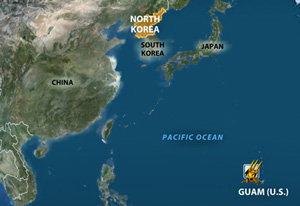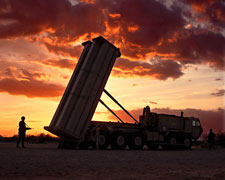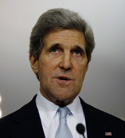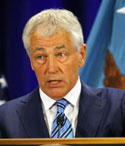redo Jump to...
print Print...
 Guam is an organized, unincorporated territory of the United States in the western Pacific Ocean. It is the largest and southernmost of the Mariana Islands.
Guam is an organized, unincorporated territory of the United States in the western Pacific Ocean. It is the largest and southernmost of the Mariana Islands.- Guam is one of five U.S. territories with an established civilian government.
- The island was controlled by Spain until 1898, when it was surrendered to the United States during the Spanish-American War and later formally ceded as part of the Treaty of Paris.
- As the largest island in Micronesia and the only U.S.-held island in the region before World War II, Guam was captured by the Japanese on December 8, 1941, just hours after the bombing of Pearl Harbor, and was occupied for two and a half years. During the occupation, the people of Guam were subjected to acts that included torture, beheadings and rape, and were forced to adopt the Japanese culture.
- Guam was subject to fierce fighting when U.S. troops recaptured the island on July 21, 1944, a date commemorated every year as Liberation Day.
- Today, Guam’s economy is supported by its principal industry, tourism, which is composed primarily of visitors from Japan. Guam’s second largest source of income is the United States military. (from wikipedia)
(from the New York Post) AP, WASHINGTON – The Pentagon is deploying a ballistic missile defense system to Guam to strengthen the Asia-Pacific region’s protections against a possible North Korean attack.
Word of the shield’s delivery came Wednesday as Defense Secretary Chuck Hagel called North Korea’s latest belligerent rhetoric a real and clear danger and threat to the U.S. and its allies.
Deployment of the Terminal High Altitude Area Defense System is the latest step the U.S. has taken to bolster forces in a show of force aimed at countering the North Korean threat.
The Pentagon already has sent bombers, stealth fighters and ships to the area.
Tensions have escalated between North and South Korea in recent weeks. The North has vowed to increase production of nuclear weapons materials and threatened a pre-emptive strike against the U.S.
Worries in Washington rose Tuesday with North Korea’s vow to increase production of nuclear weapons materials. Secretary of State John Kerry called the announced plan “unacceptable” and stressed that the US is ready to defend itself and its allies. But he and other U.S. officials also sought to lower the rhetorical temperature by holding out the prospect of the North’s reversing course and resuming nuclear negotiations.
At a joint news conference with visiting South Korean Foreign Minister Yun Byung-se, Kerry said the U.S. would proceed “thoughtfully and carefully” and in consultation with South Korea, Japan, China and others.
Defense Secretary Chuck Hagel, in a call late Tuesday to China’s defense minister, called the North’s development of nuclear weapons a “growing threat” to the U.S. and its allies.
Hagel, citing North Korea’s pursuit of nuclear weapons and ballistic missiles in his phone conversation with Chang Wanquan, said Washington and Beijing should continue to cooperate on those problems, according to a Pentagon statement describing the call.
Michael Green, an Asia specialist at the Center for Strategic and International Studies, said it should be no surprise that North Korea is vowing to restart a long-dormant nuclear reactor and ramp up production of atomic weapons material.
“This is part of their protection racket,” Green said in an interview. “I think the end state North Korea would like is that we, the U.S. in particular, but also China, Japan, South Korea, are so rattled by all this that we decide it’s just better to cut a deal with them.”
Tensions have flared many times in the six decades since a truce halted the 1950-53 Korean War, but the stakes are higher now that a defiant North Korea appears to have moved closer to building a nuclear bomb that could not only threaten the South and other US allies in Asia but possibly, one day, even reach US territory.
That explains, in part, why the US is displaying military muscle to warn the North to hold its fire.
Washington also wants to leave no doubt that it has the South’s back, and that Seoul should not act rashly. Nor does the US want South Korea to feel compelled to answer the North’s nuclear drive by building its own bomb.
“We are in the business of assuring our South Korean allies that we will help defend them in the face of threats,” Pentagon press secretary George Little said, adding, “We are looking for the temperature to be taken down on the Korean peninsula.”
Even without nuclear arms, the North poses enough artillery within range of Seoul to devastate large parts of the capital before US and South Korea could fully respond. The U.S. has about 28,500 troops in South Korea, and it could call on an array of air, ground and naval forces to reinforce the peninsula from elsewhere in Asia and the Pacific.
In just the past few months, North Korea has taken a series of steps Washington deemed provocative, including an underground nuclear test in February. In December the North Koreans launched a rocket that put a satellite into space and demonstrated mastery of some of the technologies needed to produce a long-range nuclear missile. And several weeks ago, the North threatened to pre-emptively attack the U.S. …
In response, the Pentagon announced it would beef up missile defenses based on the US West Coast, and it highlighted over a period of days the deployment of B-52 and B-2 bombers, as well as two F-22 stealth fighters, to South Korea as part of an annual US-South Korean exercise called Foal Eagle, which lasts through April.
On Tuesday, officials said the Navy was keeping the USS Decatur, a destroyer armed with missile defense systems, in the vicinity of the Korean peninsula for an unspecified period instead of continuing its journey back to the US after a Mideast deployment. And they said a similar ship, the USS McCain, had been shifted slightly to the waters off the southwest coast of the Korean peninsula as a further precautionary move.
North Korea has been an enigma to most outsiders since it was founded by Kim Il Sung in 1948. The United States has often misjudged the North’s political path. After the founding Kim died in 1994, for example, US intelligence officials said they believed his successor son, Kim Jong Il, would be more accommodating to the West.
“Flaky as he may be, (Kim Jong Il) nevertheless … realizes the only way they’re going to extricate themselves from the shambles that their economy is in now is to get outside help,” James R. Clapper Jr. told a congressional panel in January 1995. Clapper was director of the Defense Intelligence Agency at the time; today he is President Barack Obama’s most senior intelligence adviser as director of national intelligence.
From a report by the Associated Press. Reprinted here for educational purposes only. May not be reproduced on other websites without permission from The New York Post.
Questions
NOTE TO STUDENTS: Before answering the questions, read the “Background” below.
1. How does U.S. Secretary of Defense Chuck Hagel describe North Korea’s latest threats?
2. Describe the threats made by North Korea.
3. Describe the U.S. responses to North Korea’s threats. Be specific:
a) the Defense Department’s response
b) the State Department’s response
c) Do you think both responses are correct for these different government departments? Should the Department of Defense not take such a strong stand and should the State Department take a stronger stand against North Korea’s threats? Explain your answers.
4. What does Asia expert Michael Green believe to be North Korea’s motive for its latest threats?
5. How do the AP reporters who wrote this article interpret U.S. Defense Department response to North Korea? (What do they base this on?)
6. What immediate danger does North Korea pose to South Korea?
7. Re-read the last two paragraphs of the article. What do you think the reporters are implying by these statements?
CHALLENGE QUESTION: Read the commentary by Rich Lowry on missile defense at: nationalreview.com/blogs/print/343314
Although North Korea has not carried out any of its recent threats, do you think Mr. Lowry is correct in saying we should have a good missile defense system rather than “simply trust that a lunatic regime running its country like a vast prison camp will rationally calculate its self-interest as we would hope [before attacking the U.S.]“
Explain your answer.
Background
ON THE NORTH KOREAN GOVERNMENT: (from the CIA World FactBook)
- An independent kingdom for much of its long history, Korea was occupied by Japan in 1905 following the Russo-Japanese War. Five years later, Japan formally annexed the entire peninsula. Following World War II, Korea was split with the northern half coming under Soviet-sponsored Communist domination.
- After failing in the Korean War (1950-53) to conquer the U.S.-backed South Korea (Republic of Korea – ROK) by force, North Korea (DPRK), under its founder President Kim Il Sung, adopted a policy of ostensible diplomatic and economic “self-reliance” as a check against excessive Soviet or Communist Chinese influence.
- North Korea demonized the U.S. as the ultimate threat to its social system through state-funded propaganda, and molded political, economic, and military policies around the core ideological objective of eventual unification of Korea under Pyongyang’s control.
- Kim Il Sung’s son, [dictator] Kim Jong Il, was officially designated as his father’s successor in 1980, assuming a growing political and managerial role until the elder Kim’s death in 1994.
- After decades of economic mismanagement and resource misallocation, North Korea since the mid-1990s has relied heavily on international aid to feed its population while continuing to expend resources to maintain an army of approximately 1 million. [Aid agencies estimate that a famine from 1995-1997 killed 2 million to 3 million North Koreans. Foreign food aid was given to North Korea, but the government distributed the majority of it to the military and party leaders.]
- [Kim Jong-il was an oppressive dictator who required that his people call him “Dear Leader”]
- Kim Jong Un was publicly unveiled as his father’s successor in September 2010.
- Following Kim Jong Il’s death in December 2011, the regime began to take actions to transfer power to Kim Jong Un and Jong Un has now assumed many his father’s former titles and duties.
- North Korea’s history of regional military provocations; proliferation of military-related items; WMD programs including tests of nuclear devices in 2006, 2009, and 2013 (long-range missile development; as well as its nuclear, chemical, and biological weapons programs) and massive conventional armed forces – are of major concern to the international community.
THE U.S. MISSILE-DEFENSE SYSTEM:
The Strategic Defense Initiative (SDI) was proposed by U.S. President Ronald Reagan on March 23, 1983 to use ground-based and space-based systems to protect the United States from attack by strategic nuclear ballistic missiles. The SDI was intended to defend the United States from attack from Soviet ICBMs by intercepting the missiles at various phases of their flight.
The initiative focused on strategic defense rather than the prior strategic offense doctrine of mutual assured destruction (MAD), that assumed that neither side would start a nuclear war because it would not be able to avoid imminent destruction. Reagan’s “Star Wars” program drew the Soviets into a costly effort to mount a response. The race depleted Soviet funds and triggered the economic difficulties that led to the collapse of the Soviet Union in 1991. (Many in the media and liberal circles ridiculed President Reagan for being a warmonger AND a dunce; they did not understand the necessity of a missile defense system).
BALLISTIC MISSILE and DEFENSE:
A ballistic missile is a missile that follows a sub-orbital ballistic flightpath with the objective of delivering one or more warheads (often nuclear) to a predetermined target. The missile is only guided during the relatively brief initial powered phase of flight and its course is subsequently governed by the laws of orbital mechanics and ballistics. To date, ballistic missiles have been propelled during powered flight by chemical rocket engines of various types. (from en.wikipedia.org/wiki/Ballistic_missile)
- National missile defense (NMD) as a generic term is a type of missile defense: a military strategy and associated systems to shield an entire country against incoming Intercontinental Ballistic Missiles (ICBMs) or alternately more short-range ballistic missiles. The missiles could be intercepted by anti-ballistic missiles, or possibly by lasers. They could be intercepted near the launch point (boost phase), during flight through space (mid-course phase), or during atmospheric descent (terminal phase).
- Missile defense is a system, weapon, or technology involved in the detection, tracking,interception and destruction of attacking missiles. Originally conceived as a defense against nuclear-armed ICBMs, its application has broadened to include shorter-ranged non-nuclear tactical and theater missiles.
- an anti-ballistic missile (ABM) is a missile designed to counter ballistic missiles (a missile for missile defense; an interceptor). A ballistic missile is used to deliver nuclear, chemical, biological or conventional warheads in a ballistic flight trajectory. The term “anti-ballistic missile” describes any antimissile system designed to counter ballistic missiles. However the term is used more commonly for ABM systems designed to counter long range, nuclear-armed Intercontinental ballistic missiles (ICBMs). (from wikipedia)
Resources
Read a commentary on North Korea: “A Win for Missile Defense”
Read a detailed report on the U.S. Missile Defense System at:
heritage.org/Research/MissileDefense/bg1798.cfm.
Daily “Answers” emails are provided for Daily News Articles, Tuesday’s World Events and Friday’s News Quiz.






